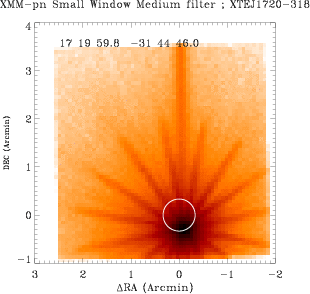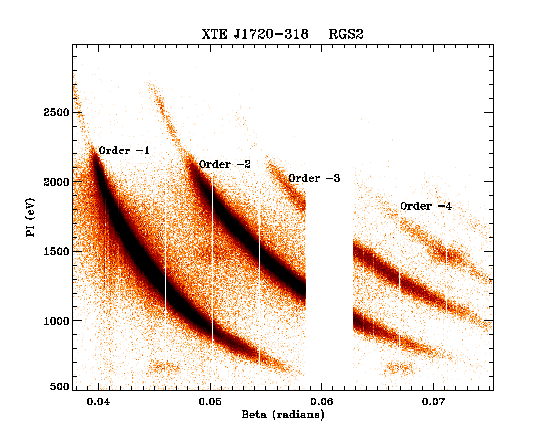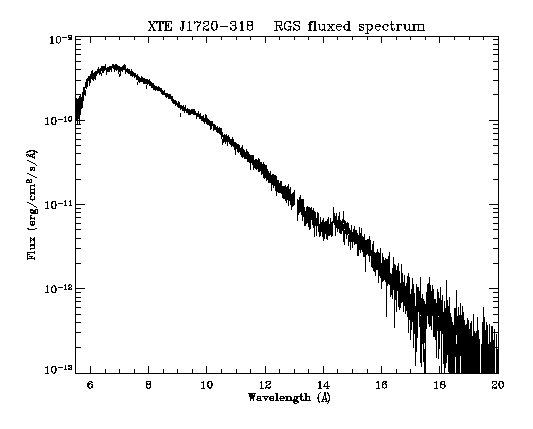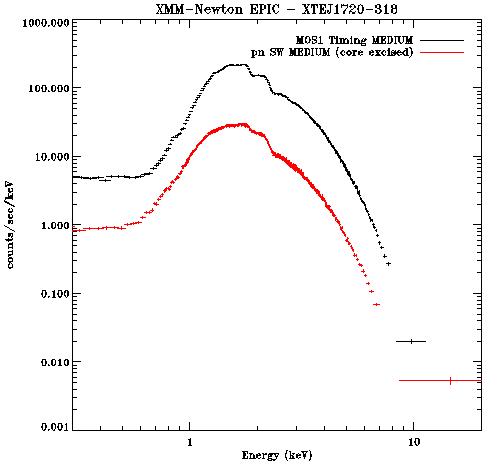xtej1720 - XMM-Newton
XMM-Newton Observation of XTE J1720-318
Events
- The X-Ray transient XTE J1720-318, was discovered by XTE on January 9 (Remillard et al., IAUC/ 5080).
- This bright transient was immediately approved by the XMM-Newton SOC for a ToO observation, and was observed as soon as it entered in the XMM-Newton visibility window.
- The observation was started on 2003-02-20T08:58:04Z under ObsId=0154750501 during XMM-Newton's revolution number 0586.
- EPIC pn was operated in Small Window mode, and MOS1 in timing mode.
- The pointing coordinates were RA = 17:19:59.8 and Dec = -31:44:46. The uncertainty in coordinates was reported as being about 20 arcseconds.
- A source was quickly identified in EPIC, ~15 arcseconds off in declination from the reported coordinates. The EPIC source position of the XTE J1720-318 X-ray counterpart was determined as RA = 17:19:59.0 and Dec -31:44:59. As stated below, this position is still subject to an uncertainty of about 4 arcseconds.
- Possible radio and infrared counterparts of XTE J1720-318 have been reported by Rupen et al. (IAUC/8054, RA=17:19:59.06 Dec=-31:44:59.7) and Kato et al. (IAUC/8056, RA=17:19:59.00 Dec=-31:45:01.2), respectively, in good agreement with the XMM-Newton position.
- The data presented here are based on a preliminary processing without the re-constituted XMM-Newton Attitude History File. Therefore, the positions quoted are subject to an uncertainty of 4 arcseconds.
Data
- The Observation Data File (ODF) is available here as 0154750501.tar.gz.
- The Pipeline Products are now also available in the ftp area. Details of the Pipeline process can be found here
Preview of XMM-Newton images (click on the images to see high resolution versions)
PN Small Window image
The XTE position of XTE J1720-318 and its reported uncertainty are marked by the circle.
Due to the extremely high brightness of the source, the mirror support construction of the XMM-Newton X-ray mirrors is reflected in the X-ray image as a number of radially oriented 'spokes'.
"Banana Plot" of the RGS2 spectrum showing up to the fourth dispersion order
Quick look analysis
RGS 1st order fluxed spectrum
The RGS first order spectrum of XTE J1720-318 showed a high count rate of 14 counts/sec. The decrease of the flux longward of 15 Angstroms is consistent with an Hydrogen column density of the order of 1022 cm-2. The observed flux in the range 1-2 keV is 1.1 10-9 erg/cm2/s.
EPIC spectra
The count rate was 588 counts/sec in EPIC-pn (core piled-up) and 346 counts/sec in EPIC-MOS (timing mode). The EPIC-pn spectrum has been extracted from an annulus between 16 and 28 arcsec from the source to avoid the piled-up core
- Removed a total of (1) style text-align:center;
- Converted a total of (4) center to div.








































 Sign in
Sign in
 Science & Technology
Science & Technology



